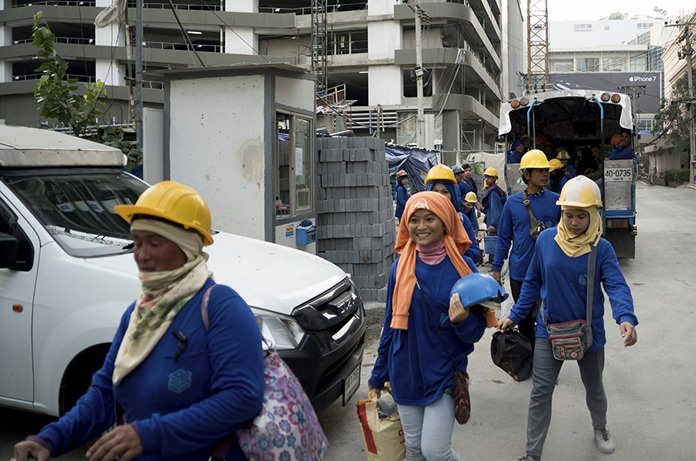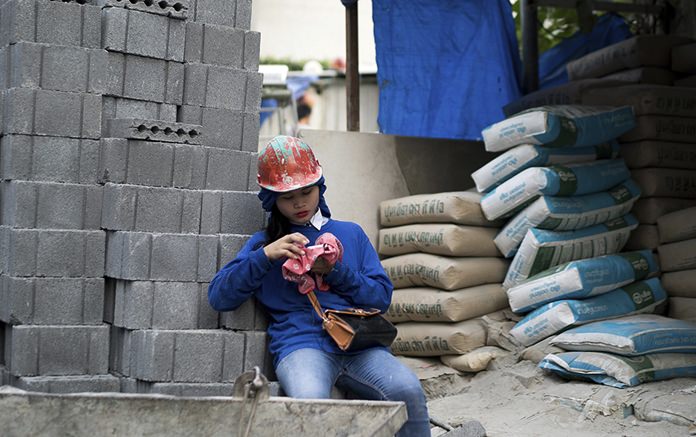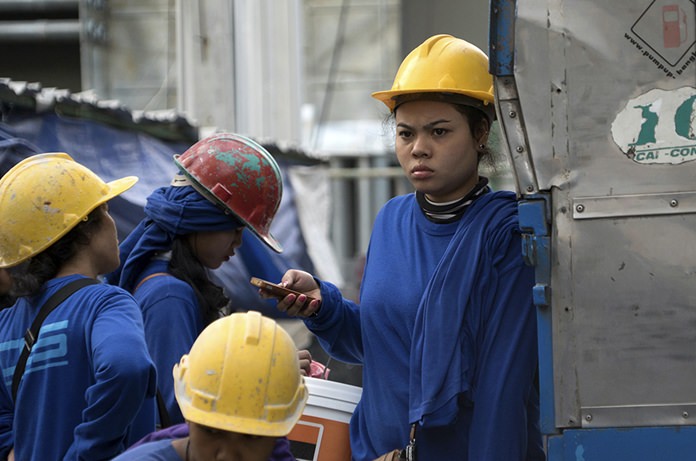Bangkok (AP) – They toil high on scaffolding, pouring concrete and twisting iron bars. At night, they squeeze into shipping containers with their husbands by the dozens to get some rest.

They are female migrant construction workers, a rarity in most parts of the world, but not in Thailand. The International Labor Organization said in a report released Tuesday that more than 200,000 women from Cambodia, Myanmar and Laos work in Thailand, accounting for almost 40 percent of the migrant construction workers in the country.
By comparison, less than 9 percent of construction workers in the U.S. are women, according to the U.S. Bureau of Labor Statistics, and a 1990 survey found that among 49 developing countries Thailand was the only one where women made up more than 10 percent of the construction workforce.

They work alongside men to smooth walls, lay bricks, and carry bags of cement on Bangkok’s high rises and railway digs.
But their large numbers don’t shield them from the same problems women in the workforce face around the world. They’re paid less and trained less. Their shipping container homes provide little security from rowdy male workers. Having a husband for protection is almost a prerequisite.
“Employers think of hiring women migrant workers as a ‘package’ with their husbands,” said Rebecca Napier-Moore, a co-author of the study. “They don’t value them as highly as men and think of them as secondary or ‘tag-alongs.’”
For migrants building stadiums in Qatar or skyscrapers in Dubai, stringent salary requirements for family visas mean that young men tend to leave their families, working to feed mouths thousands of kilometers away in India, Pakistan and Nepal. But proximity and relatively porous borders allow Cambodians and Burmese to come together as a family to don hard hats in Thailand.
“Thailand’s long land borders often run through remote areas,” said Nilim Baruah, a migration expert at the ILO. “Many migrant workers enter Thailand informally.”
For decades, Thai law has required men and women to receive equal pay for equal work – but managers say that migrant women are paid less because they are less capable. Most women work as manual laborers, cleaning up the site or moving materials around, while men do more skilled work such as welding or masonry.

More than 70 percent of the women surveyed earned wages as low as $5.34 a day. Employers often don’t pay on time, and will ask employees to lie about their wages on their contracts to get away with paying below the minimum daily wage of about $8.40.
Some women, eager to earn more, stick around for hours of overtime every day and live in fear of getting pregnant.
Thai labor legislation provides for 90 days of paid maternity leave – but many companies get around this by firing women if they’re discovered to be pregnant. Companies skirt safety regulations as well.
“Women go up high places. The structures are makeshift. Boards are tied together. There is no safety equipment, like belts,” said Thong Kham, a former construction worker. “It’s difficult and dangerous.”
Though construction fatality statistics are unreliable, the ILO estimates that construction in developing countries is three to six times risker than in Western nations. But even though the dangers are high for both men and women, some women reported that men had safety equipment training that women were excluded from.
The perils don’t stop with chemical burns and heavy machinery. At night, women retreat to company-provided container housing – with clean water and electricity, but with dim lighting, thin walls, and no locks, prompting some to wire their doors shut, scared of the drunk men outside. Some rely on their husbands to keep them safe.
But the tough conditions haven’t stopped Cambodian and Burmese women from pouring into Thailand. Many like the relative freedom of construction work, where unlike household cooks and maids they aren’t on-call 24 hours a day.




